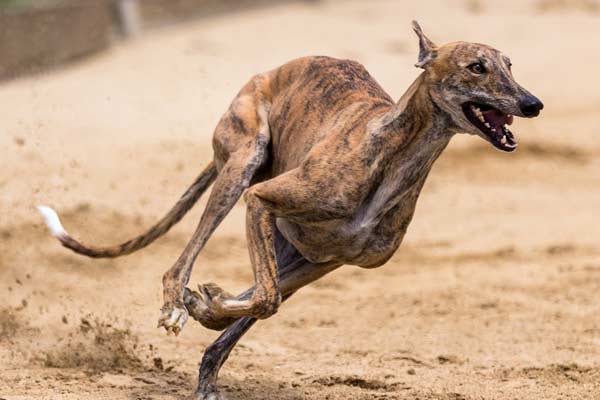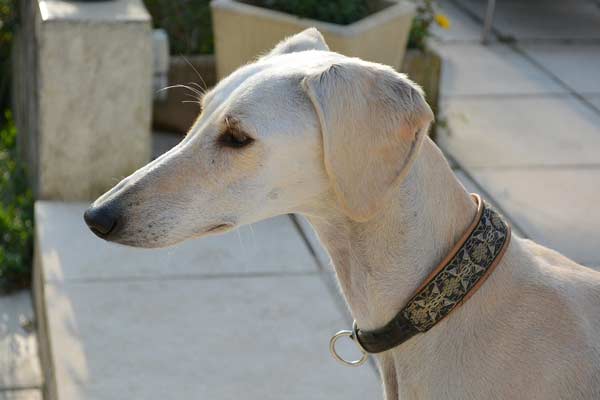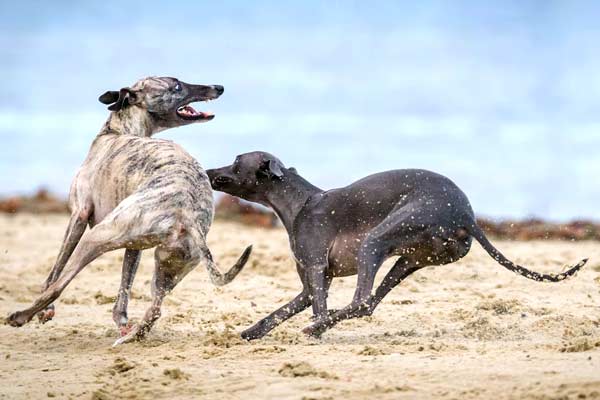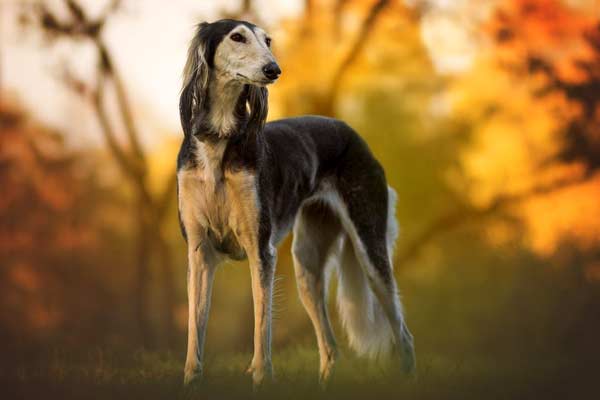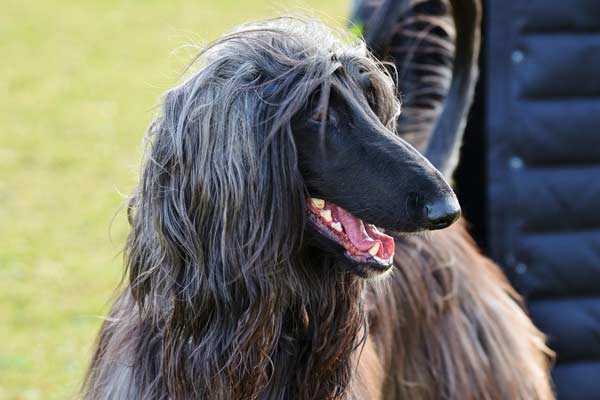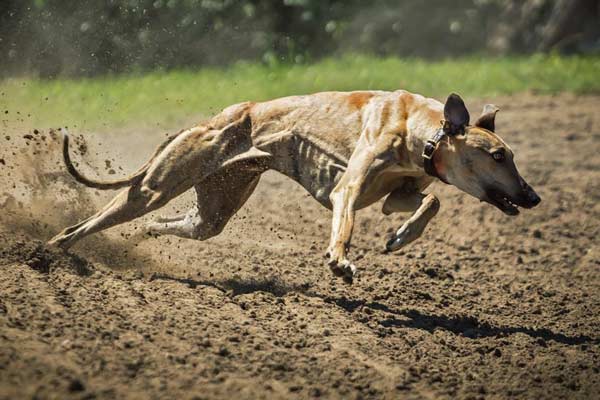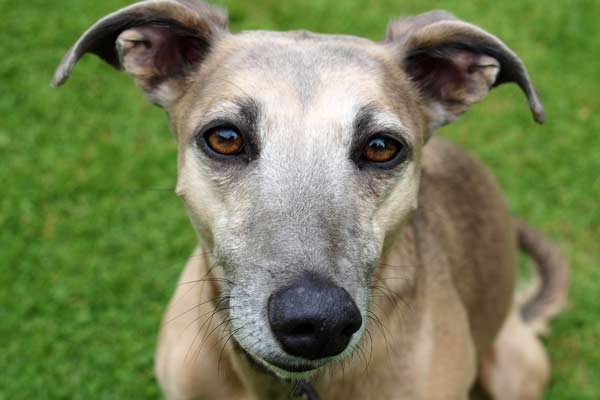Why Are Greyhounds So Skinny? Speed Phenomenon and Health
You understand their leanness as you watch Greyhounds race around a track, straining to catch that elusive mechanical rabbit.
After all, here is a dog that can run as fast as a horse. But what about when you adopt a Greyhound?
Do you ever recall thinking a Greyhound was fat when you looked around? Why are Greyhounds so skinny?
Greyhounds are thin for several reasons. Their conformation was developed from primitive times to run by sight after fleet-of-foot hares.
They easily transformed into coursing and racing dogs. Therefore, the Greyhound’s form became specialized into an aerodynamic lean physique of power, speed, and endurance.
Aspects of its conformation, such as a streamlined head, make it appear even thinner. Greyhounds have minimal body fat and high metabolisms.
Background: Greyhounds are not as skinny as they used to be
Greyhounds belong to a primitive breed that was developed for speed in hunting. Selection has always been for lean and powerful lines.
However, Greyhounds used to be 12 to 20 pounds lighter, a few inches shorter, and more slab-sided than they are as of the 2020s.
Several conflicting theories exist regarding the origin of Greyhounds. Some believe they came from the Celtics, Greeks, or Romans. Like other animals, a few prototypes may have arisen in different areas.
Many experts consider the Greyhound the oldest purebred dog, owned by Egyptian nobility as early as 6,000 BC.
These ancient civilizations used their dogs for hunting and for companionship. Greyhounds were almost sacred.
There is also compelling evidence that Middle Eastern nomads later used Greyhounds. The Greyhound was well established in form and purpose at least 2,000 years ago.
By this time, people reportedly even used Greyhounds to help them hunt on horseback.
From early on, the Greyhound was considered a specialized dog with a unique skill set.
It hunted game by sight and pursued quarry at tremendous speed with the ability to quickly shrink a sizeable head start. The Greyhound’s breeding was strictly regulated.
Although Greyhounds can run upward of 42 miles per hour, track racing was not officially born until 1912 in England.
It was thanks to the invention of the mechanical lure by Owen Patrick Smith.
However, Greyhounds featured in numerous variations of coursing until track racing. Several big-time coursing events still exist.
The Greyhound’s form and that of other sighthounds have changed little over multiple centuries.
Show Greyhounds are an inch taller than racing dogs, but their weights do not vary much between types.
A Greyhound weighs 60 to 90 pounds, with the males slightly heavier and more muscular than the females. The ideal weight is closer to 70 pounds. For a dog that is 37 inches tall from the floor to the top of its head, even 75 pounds is thin.
Greyhounds are built to race
A Greyhound is born with a racing form that ensures it is exceedingly lean.
Streamlined Head
A Greyhound is a dolichocephalic breed meaning the head is long and relatively narrow.
The widest part of the Greyhound’s head is only a little over four inches. You can contrast this width-to-length ratio of 50% in the Greyhound to that of most other dogs.
Even other dolichocephalic dogs typically have a skull width of 70% or more of its length.
Adding to the Greyhound skull’s aerodynamic shape are the absence of a stop and the rose-shaped ears, which easily fold against the head.
The muzzle is likewise narrow and tapers to the nose, drawing attention in some dogs to how thin they are.
Roomy Chest
A Greyhound has a deep but narrow chest. The chest cavity supports a large heart for improved blood circulation. It also provides for efficient expansion of the lungs.
At the same time, the chest does not have any excess breadth that would detract from the dog’s streamlined shape and speed.
The ribs support a deep chest and travel far back along the dog’s body. Well-sprung ribs are the details that best demonstrate the chest’s capacity apart from its depth.
The Greyhound is one of the few breeds in which it is normal to visualize each rib easily.
Long Lean Legs
Greyhounds have long legs that appear exceptionally thin because of the musculature of the shoulders and haunches.
Even with their apparent muscles, Greyhounds still have long, lean lines. Part of this is accomplished in the forequarters with the forelimbs’ straightness, the elbows’ placement almost directly under the shoulders, and the length of the front patterns.
In case you are unfamiliar, the pastern is the area between the toes and the first joint (wrist in front and ankle or hock in the rear).
It is also an area that encompasses the metacarpal (front) and metatarsal (rear) bones which would be the hand and foot, respectively, for humans.
In contrast to the forelegs, the rear pastern is relatively short, resulting in a short distance from the hock to the ground.
These features add to the length and apparent skinniness of the lower legs, enabling more reach in the front and more lift in the rear.
Long Body
As long as a Greyhound looks, it has a square shape that supports its exceptional balance.
Its shoulder height is 25 to 30 inches, while its length from the front of the chest to the tail is about 27 to 30.5 inches.
Their loins are long but cut, so Greyhounds typically have a drawn appearance. To complement this is one of the most extreme abdominal uptucks of all dog breeds.
The abdominal structure further adds to how skinny a Greyhound is and looks.
One place a Greyhound does not look especially thin is its back which should be broad and robust.
It allows for the spinal cord’s extreme flexion or coiling and extension during galloping.
This makes the Greyhound more like a cheetah than a horse in its running style and mechanics. You can still see a waistline when you look at your Greyhound from above.
Thin Skin and Coat
Greyhounds do not have the luxurious fluffy coats of certain other breeds to make them look bigger than they are.
They have a single-layer, thin, short coat. In some dogs, the fur is wonderful.
A Greyhound’s skin is exceedingly thin and tight-fitting without wrinkles. As part of its adaptation to racing, a Greyhound’s skin allows the capillaries to remain close to the surface, resulting in more effective cooling.
The features of the Greyhound’s skin and coat emphasize the dog’s thin frame, lean muscles, and lack of body fat.
Greyhounds have little body fat
Anyone who is an athlete or involved in weight loss or conditioning programs has at least heard of the term body fat.
For some bodybuilders and others, it is an obsession or the gold standard for the ideal physique.
However, no human can healthily approach the fat composition of a racing Greyhound at 2%.
Even a pet Greyhound typically only has a body fat percentage of under 8%. A comparison is the best illustrator of the extremes of the Greyhound’s composition and why it is so skinny.
- Women – 27%
- Man – 14.5%
- Rottweiler – 31.6%
- Standard Poodle – 24.5%
- Golden retriever – 22.7%
- Dachshund – 22.7%
- Asian Elephant – 8.5% to 10%
- Lions and Tigers – 13% in the wild, 15% to 20% in captivity
- Cats – 15% to 24%
- Pigs – 16%
Most healthy dogs have an ideal body fat content ranging from 15% to 36%. Sighthounds run much thinner (up to 17% maximum).
Mastiff family members can carry more fat than other dogs, but they are often overweight because owners misjudge their pets’ body mass and conditioning.
Fit domesticated and captive animals are close to or slightly above their ideal body condition, while wild animals are lean and sometimes underweight.
Greyhounds look too skinny next to most of their canine counterparts so that body-scoring them can be difficult.
An overweight Greyhound loses its abdominal uptuck and begins to fill out in the flank area.
They also lose their muscular definition. Fat Greyhounds are more common off the track than overly skinny ones.
Retired racing Greyhounds adapt readily to their new sedentary lifestyles and often must be encouraged to exercise.
Also, owners frequently do not adjust their dogs’ diets enough to fit their changed activity levels. A racing Greyhound can eat five times more or more than an active pet.
If you adopt your Greyhound from the track, its racing weight is a good starting point to monitor future changes in body condition.
Your dog’s racing weight is in a public database that you can find if you have a tattoo number or an official racing name.
Weight gain is insidious in retired racing Greyhounds because lighter fat tissue replaces the heavier muscles.
By feeding your Greyhound a high-quality diet and providing sufficient exercise, you can help her retain as much musculature and fitness as possible.
You can spot an underweight Greyhound if her ribs are visible from a long distance or if her vertebrae are prominent.
You will also notice that the hip bones protrude, and the eyes look sunken. The skin will begin to sag as a Greyhound loses more weight.
This video illustrates two healthy Greyhounds. Both dogs exhibit readily visible ribs, long, lean legs, exaggerated musculature of the thighs and shoulders, and streamlined heads.
The dark dog has a more drastic abdominal uptuck than the fawn Greyhound.
You can see a “heave” line across the ribs (muscular diagonal line) on the fawn dog, so the slight loss of an abdominal outline may have more to do with gender differences than excessive weight gain.
Greyhounds expend more energy than other dogs
Although it is hard to prove that Greyhounds have a higher metabolism than other breeds, they have a few characteristics that cause them to expend more energy.
- Higher lean body mass – more muscles
- Larger heart
- Skin and coat are inefficient at keeping them warm
If you feel your dog is too skinny, schedule a physical exam and diagnostic workup with a veterinarian. They will determine whether your pet is underweight.
Many friends may offer an opinion on how your dog looks, but healthy Greyhounds should appear lean.
If your dog is skinny, additional proteins and fats will help him gain weight gradually.
Carbohydrates often pack on pounds too quickly. Moreover, carbs that encourage weight gain are often unhealthy for dogs.
Sick Greyhounds lose weight sometimes
Occasionally when a Greyhound looks skinny, it is too thin. Several illnesses can cause weight loss. Some diseases cause the pounds to disappear because your dog refuses to eat.
- Pain – arthritis, cancer
- Tooth or gum disease – gingivitis and tooth root abscesses are possible
- Kidney disease or failure
- Exposure to toxins
- Stomach ulcers
- Anxiety
Other disorders cause weight loss through a process called cachexia (loss of muscle and sometimes fat, usually from a chronic disease) or a failure of the body to assimilate nutrients.
- Cancer – bone cancer most common in the breed
- Aging process
- Internal parasites – intestinal worms
- Tick-borne diseases can be expected in retired racing Greyhounds.
